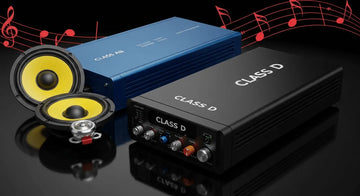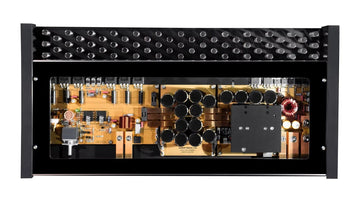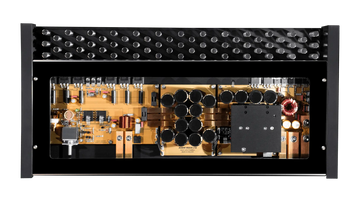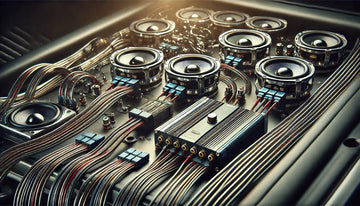2 Channel Amplifiers
Featured Products
Ground Zero GZIA 2.85 2-Channel High Quality Class A/B Amplifier
US Acoustics Wendy | 2 Channel Class AB Amplifier | 2 x 75w
Cadence XAM400.2 2-Channel Class D Powersports Amplifier - 400W RMS Orange Anodized Full Range Micro Amp
Ground Zero GZIA 2.135 2-Channel High Quality Class A/B Amplifier
Audio Dynamics ADMK300.2 2 Channel Amplifier
US Acoustics Andrea | 2 Channel Class AB Amplifier | 2 x 150w
Ground Zero GZHA MINI TWO 2-channel class D compact amplifier
Audio Wave Excel | 2 Channel Class AB Amplifier
Audio Wave Excel CA | 2 Channel Class A Amplifier
Audio Wave Excel CA | 2 Channel Class A Amplifier | Previous Demo
Audio Wave Aspire Pro USA
TRU Technology Billet B22-A v2.5 - 2-Channel Class A Amplifier
Audio Wave Aspire Pro USA (Display Model)
Audio Wave Aspire Pro V2 Class A 2-Channel Amplifier
Audio Wave Aspire Pro V2 Class A 2-Channel Amplifier | Previous Display
All products loaded
Find the Perfect 2 Channel Amplifier for Your Car Audio System

Is your car's factory sound system falling short? If your music sounds flat, distorts at high volumes, or lacks the punch and clarity you want, the fix might be simpler than you think. A dedicated 2 channel amplifier is one of the most effective upgrades for your car audio, acting as the core of a high-performance system. It boosts the weak signal from your stereo with clean, consistent power, completely transforming your listening experience.
This component is the key to unlocking your speakers' full potential. By supplying a robust and stable power source, a two channel amp enables your speakers to deliver richer bass, crisper highs, and a more dynamic, immersive soundstage. This guide covers everything you need to know about choosing the right model for your vehicle, from what a 2 channel car amp does to how to select the best one for your setup. You can also browse our extensive collection to find the perfect match for your system and budget.
Understanding 2 Channel Amplifiers for Your Vehicle
Before looking at specs and features, it's helpful to understand what a two channel amplifier is and why it's so crucial for any serious audio upgrade. Your car's factory stereo includes a small, built-in amplifier, but it's designed for cost-efficiency, not performance. It simply doesn't have enough power to drive high-quality aftermarket speakers. Adding a dedicated amplifier is like swapping a scooter engine for a V8—it provides the muscle needed for powerful, high-fidelity sound.
What Exactly is a 2-Channel Amp?
Simply put, a 2 channel amplifier is a power source designed to boost the audio signal for two separate channels, usually a left and a right speaker. This makes it the perfect choice for creating a powerful front soundstage with a pair of high-performance component or coaxial speakers. Its main job is to deliver significantly more clean power than any factory or aftermarket stereo can. This amplification process allows your music to get louder without distortion while also revealing subtle details you may have never heard before.
Unlike a 4-channel amp (for four speakers) or a monoblock amp (a single channel for power-hungry subwoofers), the 2 ch amplifier is a specialist. Its focused design also makes it incredibly versatile. While most often used for a pair of speakers, many 2-channel amps can be "bridged"—combining the power of both channels into a single, more powerful one. This makes it perfect for driving a single subwoofer, giving the 2ch amplifier the flexibility to be an excellent foundation for any great car audio system.
Why Upgrade to a Dedicated 2-Channel Car Amplifier?
The benefits of a dedicated amplifier extend far beyond just more volume. The first thing you'll notice is a dramatic improvement in clarity and detail. Underpowered speakers struggle to reproduce the full frequency range, which results in muddy sound. With ample power from a two channel car amplifier, speakers move more precisely, delivering tighter bass, clearer vocals, and crisp highs. You'll hear instruments and textures in your favorite songs that were previously hidden.
An external amp also offloads the demanding job of amplification from your stereo. This allows the head unit to focus on what it does best: processing the audio source and sending a clean, low-level signal. Freed from the strain of powering speakers, the head unit operates more efficiently, improving your entire system's performance. This separation of tasks creates a more defined soundstage and better dynamic range—the difference between a track's quietest and loudest moments—for a more immersive listening experience.
How to Choose the Best 2 Channel Car Amplifier
Now that you understand why you need one, the next step is choosing the right 2 channel car amplifier for your setup. This means matching the amp to your speakers, understanding different amplifier technologies, and identifying the features that give you the most control over your sound. Getting these details right is crucial for building a balanced, reliable, and fantastic-sounding system.
Power Output (RMS) and Speaker Compatibility
When comparing amplifiers, the most important specification is the RMS power rating. RMS (Root Mean Square) represents the continuous, real-world power an amplifier can produce. Don't be fooled by "Peak" or "Max" power ratings, which only reflect brief, unsustainable bursts. For sustained performance, RMS is the number that matters. The ideal 2 channel amplifier for car audio will have an RMS power output that matches your speakers' power handling capabilities. A good rule of thumb is to choose an amp that delivers between 75% and 150% of your speakers' continuous RMS rating. For instance, if your speakers are rated for 100 watts RMS, an amp providing 100 watts RMS per channel is a perfect match.
You also need to consider impedance, which is measured in Ohms (Ω) and represents your speakers' electrical resistance. Most car audio speakers have an impedance of 4 ohms. Amplifiers are rated to deliver different amounts of power at different impedances (e.g., 75W x 2 at 4 ohms, 125W x 2 at 2 ohms). Make sure the car amplifier 2 channel model you choose is compatible with your speakers' impedance for safe and stable operation.
Amplifier Class: A/B vs. D for Car Audio
Car amplifiers are categorized into different classes based on their circuit design, which affects their efficiency, size, and sound. For a 2-channel car amplifier, you will primarily find Class A/B and Class D models.
-
Class A/B: This traditional design is praised by audiophiles for its excellent sound quality and smooth, natural music reproduction. However, it is less efficient than Class D, converting more electrical energy into heat and requiring a larger chassis with heat sinks to stay cool.
-
Class D: This modern design is highly efficient, converting more power into sound while generating very little heat. This allows Class D amps to be much more compact, making them easier to install in tight spaces. While early Class D amps were criticized for their sound quality, modern technology has advanced to the point where they offer outstanding audio performance that rivals their Class A/B counterparts.
The choice often comes down to your priorities. If you're a purist building a high-fidelity system with plenty of installation space, a Class A/B amp is a superb choice. If you need significant power, are bridging the amp for a subwoofer, or have limited space, a highly efficient Class D 2-channel amplifier is the more practical and often preferred option.
Essential Features and Connectivity Options
Modern amplifiers include a suite of built-in tools to help you shape your sound. Crossovers are essential: a High-Pass Filter (HPF) blocks low-frequency bass from reaching smaller speakers, protecting them from damage and distortion, while a Low-Pass Filter (LPF) does the opposite, ensuring only bass frequencies go to a subwoofer. Other key features include gain controls for matching the amp's input to your stereo's output, and bass boost for adding extra punch (use it sparingly!). If you're connecting to a factory stereo without RCA outputs, look for an amp with speaker-level (high-level) inputs. Some models also include a remote level control, a small knob you can mount nearby to adjust subwoofer volume on the fly.
Installation and Setup Tips for Your Dual Channel Amp
Proper installation and tuning are just as important as choosing the right hardware. A poorly installed dual channel amp can cause poor performance, frustrating noise, or even a safety hazard. While we always recommend professional installation for the best results, understanding the basics is helpful whether you're a DIY enthusiast or just want to know what to expect from your installer.
Basic Wiring for a 2-Channel Amplifier
Every amplifier installation requires three critical connections to your vehicle's electrical system: power, ground, and remote turn-on. The power wire runs directly from the car battery's positive terminal to the amplifier and must have an inline fuse near the battery for safety. The ground wire needs to be attached to a clean, unpainted metal surface on the car's chassis—a poor ground is the top cause of unwanted engine noise. Finally, the remote turn-on wire connects to your stereo, telling the amplifier when to power on and off.
Using the correct gauge (thickness) of wire is non-negotiable. An amplifier wiring kit is the easiest way to get the right gauge for your amp's power draw. The audio signal is delivered from your stereo via RCA cables, which should be run on the opposite side of the vehicle from the power wire to prevent interference. Lastly, speaker wires connect the amplifier's output terminals to your speakers or subwoofer.
Optimizing Sound: Gain, Crossover, and Bass Boost Settings
Once your dual channel amp is wired, it's time to tune it—the final step to achieving great sound. The gain control is not a volume knob; its purpose is to match the amp's input sensitivity with the stereo's output voltage. Setting it correctly prevents "clipping," a type of distortion that can damage your speakers. The process typically involves playing a test tone, setting your stereo's volume to about three-quarters of its maximum, and slowly increasing the amp's gain until you hear distortion, then backing it off slightly.
Next, set the crossovers. If you are powering a pair of speakers, engage the High-Pass Filter (HPF) and set it to around 80Hz to block deep bass that could cause distortion. If you're running a bridged subwoofer, use the Low-Pass Filter (LPF) and set it to a similar point (around 80-100Hz) so it only plays bass notes. Use the bass boost feature with caution; a small amount can add impact, but too much will create boomy, inaccurate bass. For anyone new to car audio, we highly recommend professional installation to ensure all settings are optimized for safety and peak performance.
Explore Our Selection of 2 Channel Car Amplifiers
Now that you have the information to make a confident decision, it's time to find the perfect amplifier for your car. Our selection includes a wide variety of models to suit any application and budget, from compact, efficient units to powerful, audiophile-grade amplifiers. Our helpful on-page tools make it easy to find the right balance between features, power, and price.
Filter and Compare by Price, Brand, and Features
We've made it simple to narrow down your options. To find the best 2 channel amp price, use our sorting tool to view products from lowest to highest price. You can also filter by brand, RMS power output, and specific features to quickly find models that meet your needs. Whether you're looking for an affordable car amplifier 2 channel low price option for a simple factory upgrade or a high-end dual channel amp to power elite component speakers, our filters will help you pinpoint the ideal choice. Use our comparison tool to view key specifications side-by-side and make a confident final decision.
Popular 2 Channel Amplifier Brands and Models
We proudly carry a wide range of the industry's most trusted brands, known for reliability, innovation, and performance. Explore models from leaders like Rockford Fosgate, JL Audio, Kicker, Alpine, and Kenwood, each offering unique strengths. From the raw power Kicker is known for to the pristine sound quality of JL Audio, you'll find an amplifier that aligns with your audio goals. Browse our listings to see what's available for quick shipping or find a 2 channel amp near me for local pickup. Start exploring now and take the first step toward achieving incredible sound in your car.
Common Questions About 2 Channel Amps
It's normal to have questions when getting into car audio amplification. Here, we answer some of the most common inquiries about the versatile 2 ch amplifier to help clarify its role and benefits.
What Speakers Can a 2-Channel Amp Power?
A 2-channel amp is valued for its flexibility. Its most common use is powering a single pair of speakers, like your front component or coaxial speakers, to create a clean and powerful stereo soundstage. However, it can also be "bridged" by combining the output of both channels into a single, more powerful mono output. This is perfect for powering a moderately-sized subwoofer, making it an excellent choice for adding impactful bass. This versatility allows a single 2 channel amplifier to fill two very different but equally important roles in a car audio system.
Is Professional Installation Necessary?
While experienced DIY enthusiasts who understand car electrical systems can install an amplifier, we strongly recommend professional installation for most people. A professional installer ensures a safe, secure connection to your vehicle's electrical system, preventing potential shorts or damage. They also have the tools and experience to properly tune the amplifier's gain and crossover settings for optimal sound quality and speaker protection. Additionally, professional installation often helps preserve the warranty on both the amplifier and your vehicle.
How Do I Know if My Car Needs a 2 Channel Amplifier?
Several clear signs indicate your system would benefit from a 2 channel amp. The most common is after upgrading your factory speakers. Aftermarket speakers are designed for more power than a factory stereo can provide, so without an amp, they will sound underwhelming and distort easily at higher volumes. Another sign is if your music sounds lifeless and lacks dynamic impact. An amplifier provides the power needed for crisp details and powerful sound. Finally, if you want to add a single subwoofer for better bass, a bridgeable two channel amplifier is one of the most cost-effective solutions.
2 Channel Amplifiers
Frequently Asked Questions
Can I run 4 speakers off a 2 channel amp?
How does a 2 channel amp work?
Do I need a 2-channel or 4-channel amp?
Can a 2 channel amp be bridged?
What can a 2 channel amp power?
Related Articles

Class AB vs Class D Amplifiers: Which One Should You Choose?

The Best Class A Amplifier: Key Features and Benefits Explained

Class A Car Amplifiers: The Gold Standard in Sound Quality


















